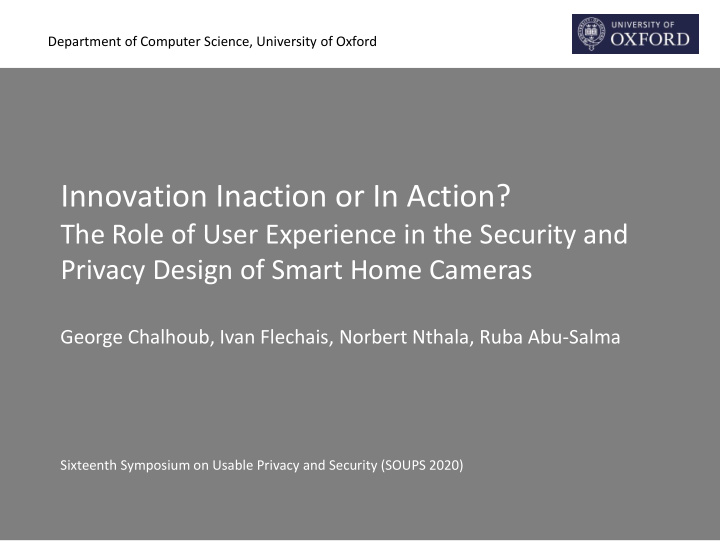



Department of Computer Science, University of Oxford Innovation Inaction or In Action? The Role of User Experience in the Security and Privacy Design of Smart Home Cameras George Chalhoub, Ivan Flechais, Norbert Nthala, Ruba Abu-Salma Sixteenth Symposium on Usable Privacy and Security (SOUPS 2020)
Department of Computer Science, University of Oxford Introduction • Smart homes offer great promise but have clear security and privacy risks • Demographically-diverse home users drive a need for user-centered security and privacy • Looking beyond usability, we look at how designers factor User Experience (UX) principles into the security and privacy design of smart cameras
Department of Computer Science, University of Oxford Methods • 20 employees from 3 companies (6, 8, 6) • Recruitment from online platforms • Semi-structured interviews (~52 minutes) • Remote interviews (Zoom, Skype) • Grounded Theory analysis (155 codes)
Department of Computer Science, University of Oxford Results • Stakeholders divided into 6 groups according to job responsibilities: security, regulatory, UX, management, software and hardware. • Five themes identified through Grounded Theory: • Development Process • UX in Security Design • UX in Privacy Design • Innovation in Security and Privacy Design • Trust
Department of Computer Science, University of Oxford Development Process • Agile methodology • Data protection regulation and compliance • Delayed Effect • Obtaining consent • Withdrawing consent
Department of Computer Science, University of Oxford UX in Security Design • UX was not explicitly factored into security design • Incompatibilities between UX & Security Design • Lack of security expertise in design teams • Security seen as a technical-only problem • Designers had no sight of security requirements
Department of Computer Science, University of Oxford UX in Privacy Design • UX was factored into privacy design • Alignments between UX & Privacy Design • Giving users control • Being transparent with users • Obtaining explicit consent
Department of Computer Science, University of Oxford Innovation in Security and Privacy Design • UX helped design innovative privacy solutions • Novel features evaluated with usability testing • Novel features supported with qualitative- quantitative research • UX did not help design innovative security solutions • Need for tried-and-tested established solutions • New solutions increase uncertainty
Department of Computer Science, University of Oxford Trust • Improved UX to build and nurture trust: • Creating a customer-first culture • Take an interest in protecting user privacy • Tried and tested security to protect trust relationships: • Policies to deal with security vulnerabilities • Requirements for responding to security incidents
Department of Computer Science, University of Oxford Implications • Innovation in security and privacy design • Established security solutions • Security solutions from reputable vendors • Security design in agile development • Security by design in agile • “Security says no”
Department of Computer Science, University of Oxford Conclusion • Explicitly innovate through UX of security • Align security and privacy in UX • Factor UX into data protection compliance
Department of Computer Science, University of Oxford Thank You george.chalhoub@cs.ox.ac.uk
Recommend
More recommend